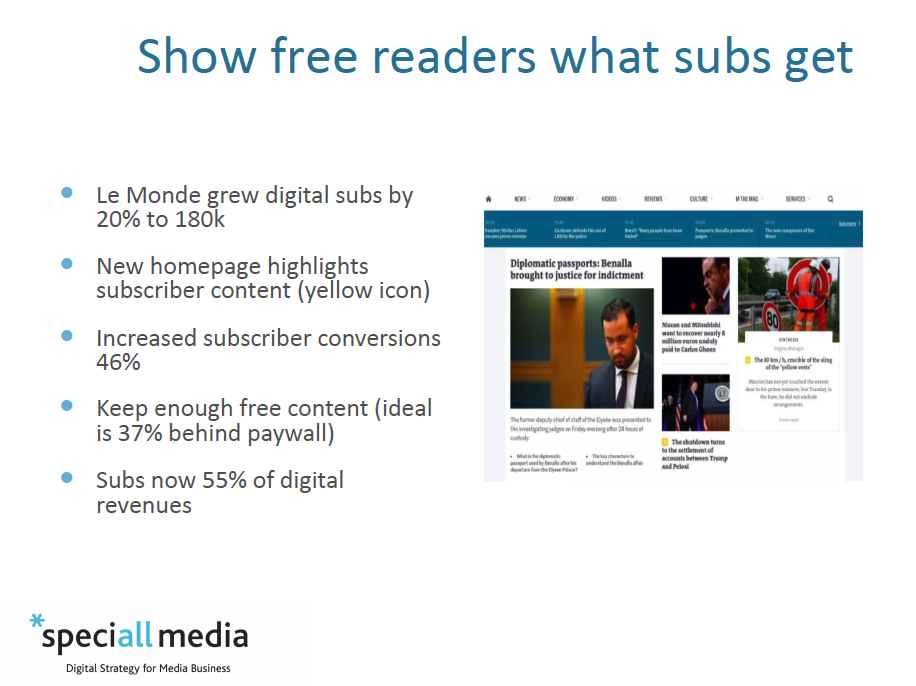How can publishers get started on digital paywalls and subscriptions? I chaired two roundtables at the PPA IndPub event in November. Both groups were a mix of consumer and B2B publishers. Everyone was at a different stage in their subscriptions journey, but these were the most common questions – and some of the practical solutions we discussed.
1. How to move from free to paid?
This is a common issue for B2B publishers who were previously controlled circulation. But many consumer publishers have operated free, ad funded websites. All publishers need to start putting more content behind a data wall or a paywall. The first step is registration for some content. Once you have registration you will get more insight into who is reading what content (see point 4). The basic principle is that you can’t charge for stuff that people used to get for free. Instead, invent a new and more valuable type of content – could be a digest, directory, report, review or guide – that you know they will value. Talk to your customers to check this fills an information gap before you launch.
2. What (online) content should be free and what behind paywalls?
Most publishers benefit from some content being freely available (and shareable socially) to build awareness of what they do. This might be news or more lightweight articles. Or you can give casual visitors short term access to your premium content via free trials, a metered model (x articles a week) or just short-term sampling. Work out what content is truly exclusive and useful/interesting – this is your premium or subscription content.
3. What subs content to put in print and what online?
Some subs content works much better online – directories and data-based content, or material where readers have very specific interests and want to be able to search easily. If you have a bundled subscription package (see point 6) you don’t have to replicate everything in print AND online – play to their strengths. Many publishers are moving to less frequent print publications (monthly or even quarterly, from weekly) that serve a different information need, and ensuring their archive content is easily searchable online. In many markets, 80% of the perceived value is in your archive content, not what you have just published.
4. How to use data on customers to decide type of subs packages to offer?
Registration walls provide fabulous insights into who is reading what. This allows you to segment your audience and make different offers to different groups. Email newsletters are often the biggest traffic driver – so work out how to make them more relevant to different segments. And some in your audience might prefer a “light” subscription while others want more “premium” access. And watching the data on subscriber behaviour can help you spot renewal risks and enhance retention.
5. How to set pricing for subs?
Test, test, test. Try not to get fixated on annual packages. In many markets monthly or quarterly subs packages are easier for people to try out. Variations of the Economists “12 issues for £12” provide a low-cost way to try out the content.
6. What turns a subscription into a membership package?
If you believe that your print and online content offers are meeting different needs, offer a bundled package. Many B2B publishers include learning credits or conference passes in subs packages. If you can offer opportunities for your subscribers to get together at live events or online, then the subscription becomes more like a membership.
7. Do micropayments work?
In spite of many micropayment platforms launching, there doesn’t seem to be a strong appetite among readers to use them extensively. It’s a hassle to have to top up different wallets. I have seen some evidence, however, that 10-15% of people who buy one-off content or day passes do eventually become paid subscribers, so it’s part of the funnel.
If you’d like to receive a copy of my collection of publisher subs case studies (example above), or you have further questions on the ideas in this document, please get in touch.
About the author
Carolyn Morgan has bought, sold, launched and grown specialist media businesses across print, digital and live events. A founder of the Specialist Media Show (sold in 2014) she now advises media businesses large and small on their digital strategy through her consultancy Speciall Media.

